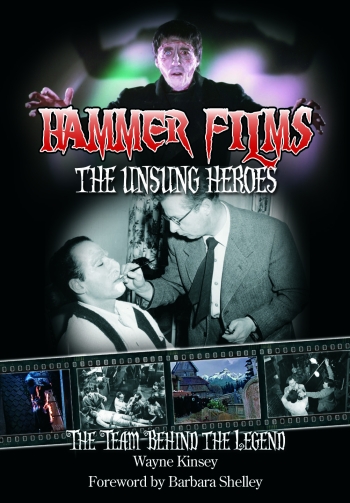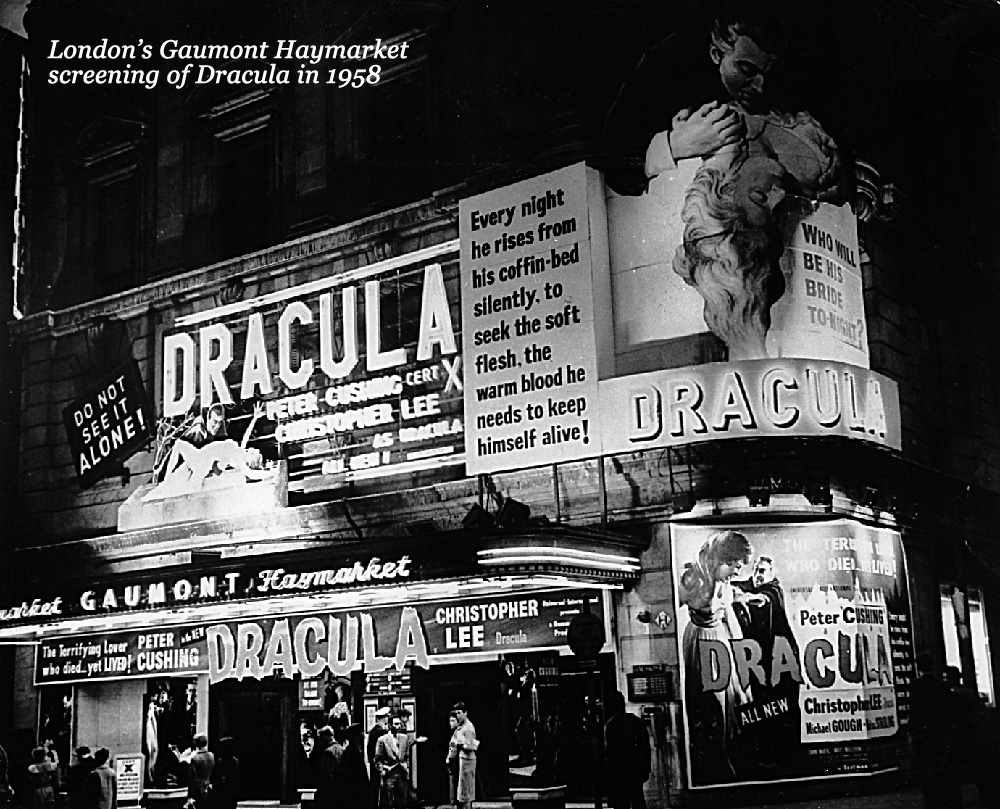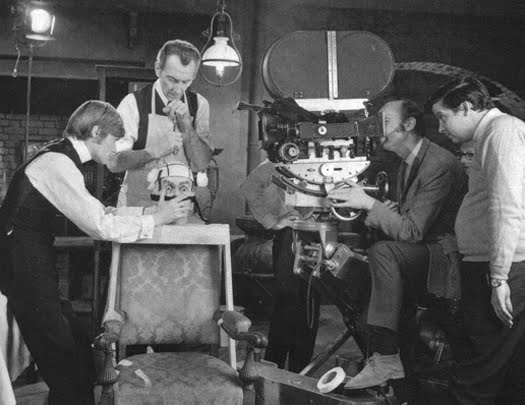 The horror of Hammer has been extremely influential in my life, starting as a child and later as a teenager as I watched the Technicolor blood drip on screen as the stories of monsters like Frankenstein’s creature, Dracula, and the mummy played out in front of me on the television screen. In fact, it was Hammer’s films that would later give me a taste for discovering Universal’s horror films that had preceded them.
The horror of Hammer has been extremely influential in my life, starting as a child and later as a teenager as I watched the Technicolor blood drip on screen as the stories of monsters like Frankenstein’s creature, Dracula, and the mummy played out in front of me on the television screen. In fact, it was Hammer’s films that would later give me a taste for discovering Universal’s horror films that had preceded them.
Several books have been published over the last few years focused on various aspects of the horror produced by Hammer Films, including overviews of the films themselves, the women of Hammer, and the poster art from the films. One of the recent book treatments is Hammer Films: The Unsung Heroes (Tomahawk Press, 2010) by Wayne Kinsey.
This is the real Hammer story: An oral history detailing the fascinating biographies of Hammer’s key players, many telling their stories for the first time in all new interviews specially commissioned for this book. This is their fascinating story. From the lowly tea boy to the most vociferous producer, each made their own unique contributions to a group of films that have since achieved cult status around the world. We will learn about their trade and their achievements but above all see their valued place in the Hammer puzzle that became the envy of the British film industry.
The key to Hammer’s success were these talented individuals. A group of unsung heroes and experts in their fields, they came together by chance to form a well oiled machine producing lavish looking features at miniscule budgets. For some, their work at Hammer would be the stepping stone to bigger things (even Oscars!); all moving on to make major contributions to international film and television.
Crammed with blood rare behind the scenes photos, read this and you’ll see why Hammer’s films achieved a standard that other rival companies could only dream of. Written by the highly acclaimed Hammer expert Wayne Kinsey, this book goes where no book on Hammer has ever gone before!
Wayne Kinsey made some time to talk about his book in the following interview.
TheoFantastique: Thank you for answering a few questions regarding the thesis of your book. You have written a number of books detailing various aspects of Hammer Films. How did you come to develop this research and writing interest?
Wayne Kinsey: I became a Hammer fan around the age of 10 in 1971. They used to put one on every Friday night after News at Ten. My parents allowed me to stay up and I got hooked. A few years later I started to collect books and magazines on horror films and became interested in how they were made. It was a lonely pursuit at first – the world was very different without the Internet back then – and it was many years later, in 1985, that I found my first Hammer film convention and started to meet people who’d worked on these films. The first person I met was make-up man Roy Ashton. I was a medical student at the time and he was as interested in me as I was with him, keen to know what I thought of his work since I was a student of anatomy and he always strived to get his creations anatomically correct. He did and that’s why Hammer monsters are remembered so well. This was all coupled with a love for writing and eventually I felt it was time to make my mark. I started the fanzine The House that Hammer Built in 1997 and that spawned a lot of my own research into the company.
TheoFantastique: Do you see your books as functioning in some ways as a preservation of cinema history related to Hammer’s contribution to horror and other genres?
Wayne Kinsey: Absolutely. Apart from the films themselves I fell in love with the whole Hammer back story and how they managed to put out such lavish looking films with meagre budgets. As a doctor, it’s always great to get away from the stress of the job and unwind with a Hammer film and this is my thanks to all those film makers in giving me a chance to escape, knowing that the extended Hammer family will take care of me for the next 90 minutes. Here I’m giving due credit to names that you only second glance in the credits as you tap your fingers waiting for the film to start – and back then only heads of department were credited. What a lovely bunch they were too, very modest and amazed that the films became cult classics. My only regret is not doing it 10 years ago. It reminded me how many great Hammer friends we’ve lost on the way and I would have loved for them to see the book.
 TheoFantastique: As the subtitle of your book indicates, you share the contributions of a great number of lesser known people behind the cameras who contributed to Hammer’s classic films. How did you come to see this as a collection of stories that needed to be told?
TheoFantastique: As the subtitle of your book indicates, you share the contributions of a great number of lesser known people behind the cameras who contributed to Hammer’s classic films. How did you come to see this as a collection of stories that needed to be told?
Wayne Kinsey: The reason Hammer’s films outshone their competitors with similar budgets was down to team work. Early on they realised it was cheaper to rent an old mansion and shoot the films in the rooms and on the grounds than it was to rent out expensive space in established film studios. They soon discovered a ramshackled manor house on the banks of the Thames outside Windsor and this became Bray Studios, their own studio. This allowed Hammer to build up an almost repertory team of technicians that gave the early horror films a unique identity of their own. Each department made their own vital contribution and I thought it was time to make these lesser known names more familiar. It was then I recognised that a lot of them have their own individual stories, some more compelling than the films they made, and you realise that ‘Hammer quality’ was no fluke. For example, legendary director John Huston once said that Hammer assistant director Bert Batt was among two of the finest in the film industry. Some were already veterans, others were training for greatness, even Oscars. Among them were film pioneers, for example special effects genius Les Bowie. Before the days of CGI, crafty backgrounds relied on matte paintings – glass paintings incorporated with the live footage that added snow capped peaks and turrets to the modest sets on the Bray back lot. Les was a POW in WW2. He could paint like life and used to make forged passports for escape attempts, stamping them with stamps he made from potatoes. He created the breathing apparatus for tunnel digging and made decoys to keep the guards occupied during escape attempts – just the background for a future film SPFX man! His story ended tragically – he died the night his name was announced among the winners for the SPFX Oscar for Superman, so never learnt of his accolade.
TheoFantastique: How do the stories of these unsung heroes contribute to those we have heard previously about Hammer’s actors, directors, and at times, composers?
Wayne Kinsey: As I said, their jobs were just as important. It was all team work. We all remember directors but forget that their concentration on set is only maximal when their assistant directors are efficient and their films would be hopeless unless they were photographed properly by the camera crew or cut together properly by the editor. I first took the approach of looking at Hammer department by department in The House that Hammer Built and I expanded it for this work. Digging behind each job, you realise just how much you take for granted and you develop a greater understanding and appreciation of their crafts. Continuity women for example. Not only do they have to watch continuity of everything on set because scenes are not shot in order, they have to watch dialogue during shooting, time everything, and then type up copious reports afterwards, including one for the editor so he knows which are the preferred director’s takes to cut together. I’m sure they developed the word multitasking just for them!
TheoFantastique: Looking back in historical retrospective, how significant was Hammer’s contribution to genre cinema?
 Wayne Kinsey: I always say that to look at the impact of Hammer you have to look at the films in the context of the period they were made. Whilst they may look tame by today’s standards, back in the Fifties they were break through films, introducing Technicolor blood to horror films as well as spicing up the sexual elements. Censors and critics were revolted but their condemnation only drove the public in all the more to see them and they wanted more! Hammer’s Dracula was so successful when it was released in 1958 that it broke box office opening records around the world and revenue from that one film saved the then ailing Universal Pictures, who had co-financed it with Hammer, from bankruptcy. Then in 1968 they won the prestigious Queen’s Award for Industry for overseas revenue, an accomplishment unprecedented by any other British film company.
Wayne Kinsey: I always say that to look at the impact of Hammer you have to look at the films in the context of the period they were made. Whilst they may look tame by today’s standards, back in the Fifties they were break through films, introducing Technicolor blood to horror films as well as spicing up the sexual elements. Censors and critics were revolted but their condemnation only drove the public in all the more to see them and they wanted more! Hammer’s Dracula was so successful when it was released in 1958 that it broke box office opening records around the world and revenue from that one film saved the then ailing Universal Pictures, who had co-financed it with Hammer, from bankruptcy. Then in 1968 they won the prestigious Queen’s Award for Industry for overseas revenue, an accomplishment unprecedented by any other British film company.
TheoFantastique: Wayne, thank you again for your time in this interview, and for documenting and sharing the work of Hammer’s unsung heroes.
Related post:
“The Art of Hammer: Horror, Beauty, and a Vanishing Art Form”





There are no responses yet